
Concept explainers
(a)
Interpretation:
The structure of the molecule is to be drawn and the IUPAC name is to be provided that corresponds to the given trivial name.
Concept introduction:
Carboxylic acids are the compounds containing

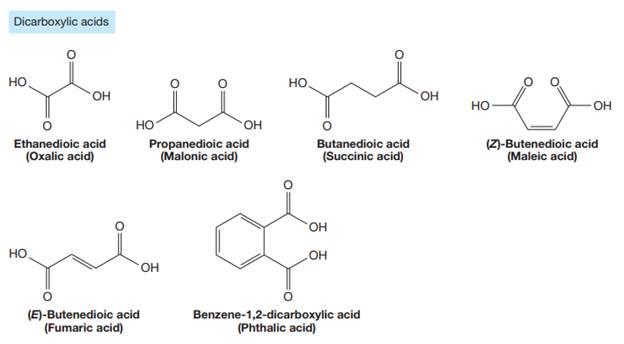
The carbonyl carbon atom is always numbered as C1 and the numbering continues. The substituents, if any, attached to the carbon chain are names according to the alphabetical order and the lowest locator number.
The trivial names of carboxylic acids are in the general form alkionic acid, while the IUPAC names are in the general form alkanoic acid. The suffix ‘ionic’ is replaced by ‘noic’ in the IUPAC name.
Answer to Problem F.12P
The structure of the molecule that corresponds to the given trivial name
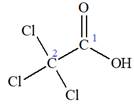
The IUPAC name of
Explanation of Solution
The given IUPAC name is

The portion ‘
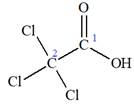
The IUPAC name of
The structure of the compound is drawn and the IUPAC name of the compound is written that corresponds to the given trivial name.
(b)
Interpretation:
The structure of the molecule is to be drawn and the IUPAC name is to be provided that corresponds to the given trivial name.
Concept introduction:
Carboxylic acids are the compounds containing

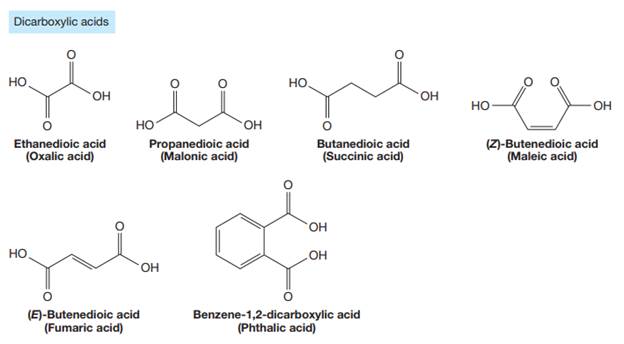
The carbonyl carbon atom is always numbered as C1 and the numbering continues. The substituents, if any, attached to the carbon chain are names according to the alphabetical order and the lowest locator number.
The trivial names of carboxylic acids are in the general form alkionic acid, while the IUPAC names are in the general form alkanoic acid. The suffix ‘ionic’ is replaced by ‘noic’ in the IUPAC name.
Answer to Problem F.12P
The structure of the molecule that corresponds to the given trivial name
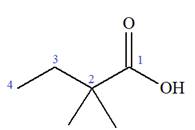
The IUPAC name of
Explanation of Solution
The given IUPAC name is
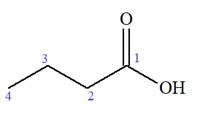
The prefix ‘2, 2-dimethyl’ indicates that the methyl group is attached at C2, and C2 carbon atoms of the butyric acid. The structure of
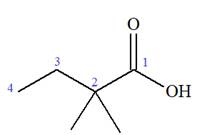
The trivial names of carboxylic acids are in the general form alkionic acid while the IUPAC names are in the general form alkanoic acid. The suffix ‘ionic’ is replaced by ‘noic’ in the IUPAC name.
The butyric acid is the trivial name, its IUPAC name is butanoic acid. Thus, the IUPAC name of
The structure of the compound is drawn and the IUPAC name of the compound is written that corresponds to the given trivial name.
(c)
Interpretation:
The structure of the molecule is to be drawn and the IUPAC name is to be provided that corresponds to the given trivial name.
Concept introduction:
Carboxylic acids are the compounds containing

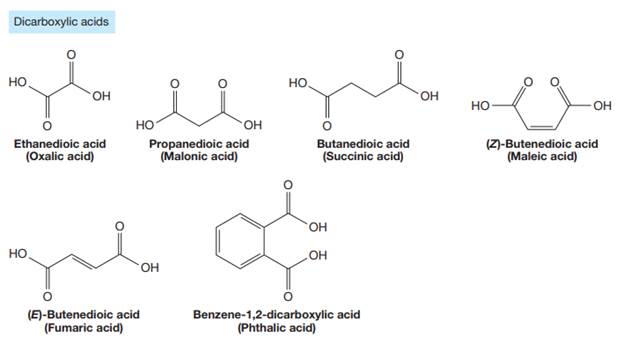
The carbonyl carbon atom is always numbered as C1 and the numbering continues. The substituents, if any, attached to the carbon chain are names according to the alphabetical order and the lowest locator number.
The trivial names of carboxylic acids are in the general form alkionic acid, while the IUPAC names are in the general form alkanoic acid. The suffix ‘ionic’ is replaced by ‘noic’ in the IUPAC name.
Answer to Problem F.12P
The structure of the molecule that corresponds to the given trivial name
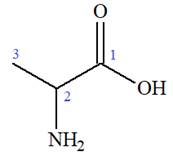
The IUPAC name of
Explanation of Solution
The given IUPAC name is
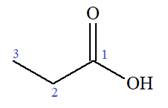
The prefix ‘2-amino’ indicates that

The trivial names of carboxylic acids are in the general form alkionic acid while the IUPAC names are in the general form alkanoic acid. The suffix ‘ionic’ is replaced by ‘noic’ in the IUPAC name.
The propionic acid is the trivial name; its IUPAC name is propanoic acid. Thus, the IUPAC name of
The structure of the compound is drawn and the IUPAC name of the compound is written that corresponds to the given trivial name.
(d)
Interpretation:
The structure of the molecule is to be drawn and the IUPAC name is to be provided that corresponds to the given trivial name.
Concept introduction:
Carboxylic acids are the compounds containing


The carbonyl carbon atom is always numbered as C1 and the numbering continues. The substituents, if any, attached to the carbon chain are names according to the alphabetical order and the lowest locator number.
The trivial names of carboxylic acids are in the general form alkionic acid, while the IUPAC names are in the general form alkanoic acid. The suffix ‘ionic’ is replaced by ‘noic’ in the IUPAC name.
Answer to Problem F.12P
The structure of the molecule that corresponds to the given trivial name
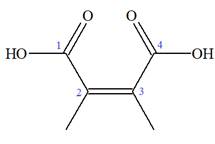
The IUPAC name of
Explanation of Solution
The given IUPAC name is

Note the stereochemistry about the doubly bonded carbon atoms. The two high-priority groups are on the same side of the double bond making it (Z) stereoisomer.
The prefix
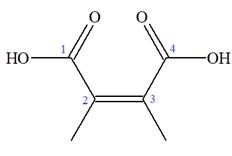
As the longest carbon chain has four atoms, the root name for carboxylic acid is
The structure of the compound is drawn and the IUPAC name of the compound is written that corresponds to the given trivial name.
(e)
Interpretation:
The structure of the molecule is to be drawn and the IUPAC name is to be provided that corresponds to the given trivial name.
Concept introduction:
Carboxylic acids are the compounds containing

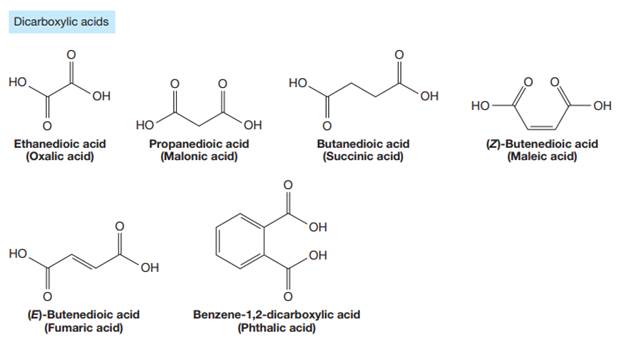
The carbonyl carbon atom is always numbered as C1 and the numbering continues. The substituents, if any, attached to the carbon chain are names according to the alphabetical order and the lowest locator number.
The trivial names of carboxylic acids are in the general form alkionic acid, while the IUPAC names are in the general form alkanoic acid. The suffix ‘ionic’ is replaced by ‘noic’ in the IUPAC name.
Answer to Problem F.12P
The structure of the molecule that corresponds to the given trivial name
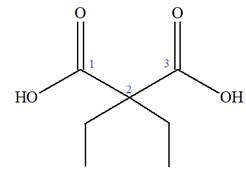
The IUPAC name of
Explanation of Solution
The given IUPAC name is

The prefix ‘diethyl’ in the name suggests that an ethyl group is attached at C2 carbon atom of the root. The locator numbers 2 and 2 are not included in the name because there is only one carbon atom to which any substituent could get attached. Thus, the complete structure of

As the longest carbon chain has three atoms, the root name for this dicarboxylic acid is
The structure of the compound is drawn and the IUPAC name of the compound is written that corresponds to the given trivial name.
Want to see more full solutions like this?
Chapter F Solutions
EBK GET READY FOR ORGANIC CHEMISTRY
- 19.78 Write the products of the following sequences of reactions. Refer to your reaction road- maps to see how the combined reactions allow you to "navigate" between the different functional groups. Note that you will need your old Chapters 6-11 and Chapters 15-18 roadmaps along with your new Chapter 19 roadmap for these. (a) 1. BHS 2. H₂O₂ 3. H₂CrO4 4. SOCI₂ (b) 1. Cl₂/hv 2. KOLBU 3. H₂O, catalytic H₂SO4 4. H₂CrO4 Reaction Roadmap An alkene 5. EtOH 6.0.5 Equiv. NaOEt/EtOH 7. Mild H₂O An alkane 1.0 2. (CH3)₂S 3. H₂CrO (d) (c) 4. Excess EtOH, catalytic H₂SO OH 4. Mild H₂O* 5.0.5 Equiv. NaOEt/EtOH An alkene 6. Mild H₂O* A carboxylic acid 7. Mild H₂O* 1. SOC₁₂ 2. EtOH 3.0.5 Equiv. NaOEt/E:OH 5.1.0 Equiv. NaOEt 6. NH₂ (e) 1. 0.5 Equiv. NaOEt/EtOH 2. Mild H₂O* Br (f) i H An aldehyde 1. Catalytic NaOE/EtOH 2. H₂O*, heat 3. (CH,CH₂)₂Culi 4. Mild H₂O* 5.1.0 Equiv. LDA Br An ester 4. NaOH, H₂O 5. Mild H₂O* 6. Heat 7. MgBr 8. Mild H₂O* 7. Mild H₂O+arrow_forwardLi+ is a hard acid. With this in mind, which if the following compounds should be most soluble in water? Group of answer choices LiBr LiI LiF LiClarrow_forwardQ4: Write organic product(s) of the following reactions and show the curved-arrow mechanism of the reactions. Br MeOH OSO2CH3 MeOHarrow_forward
- Provide the correct IUPAC name for the compound shown here. Reset cis- 5- trans- ☑ 4-6- 2- 1- 3- di iso tert- tri cyclo sec- oct but hept prop hex pent yl yne ene anearrow_forwardQ6: Predict the major product(s) for the following reactions. Note the mechanism (SN1, SN2, E1 or E2) the reaction proceeds through. If no reaction takes place, indicate why. Pay attention to stereochemistry. NaCN DMF Br σ Ilm... Br H Br H H NaCN CH3OH KOtBu tBuOH NaBr H₂O LDA Et2O (CH3)2CHOH KCN DMSO NaOH H₂O, A LDA LDA Systemarrow_forwardQ7: For the following reactions, indicate the reaction conditions that would provide the indicated product in a high yield. Note the major reaction pathway that would take place (SN1, SN2, E1, or E2) Note: There may be other products that are not shown. There maybe more than one plausible pathway. Br H3C OH H3C CI ... H3C SCH2CH3 CI i SCH2CH3 ཨ་ Br System Settarrow_forward
- Q2: Rank the compounds in each of the following groups in order of decreasing rate of solvolysis in aqueous acetone. OSO2CF3 OSO2CH3 OH a. b. CI Brarrow_forwardох 4-tert-butyl oxy cyclohex-1-ene Incorrect, 1 attempt remaining The systematic name of this compound classifies the -OR group as a substituent of the hydrocarbon, which is considered the principal functional group. The ether substituent is named with the suffix 'oxy'. The general format for the systematic name of a hydrocarbon is: [prefix/substituent] + [parent] + [functional group suffix] Substituents are listed in alphabetical order. Molecules with a chiral center will indicate the absolute configuration at the beginning of its name with the R and S notation.arrow_forward5. Compressibility (6 points total). The isothermal compressibility is a measure of how hard/easy it is to compress an object (how squishy is it?) at constant temperature. It is др defined as Br=-()=-(200²)T' (a) You might wonder why there is a negative sign in this formula. What does it mean when this quantity is positive and what does it mean when this quantity is negative? (b) Derive the formula for the isothermal compressibility of an ideal gas (it is very simple!) (c) Explain under what conditions for the ideal gas the compressibility is higher or lower, and why that makes sense.arrow_forward
- 19. (3 pts) in Chapter 7 we will see a reaction of halocyclohexanes that requires that the halogen occupy an axial position with this in mind, would you expect cis-1-bromo-3-methylcyclohexane or trans-1-bromo-3-methylcyclohexane to be more reactive in this reaction? Briefly explain your choice using structures to support your answer. Mere-eries-cecleone) The tran-i-browse-3-methylcyclohexionearrow_forwardPlease help me calculate the undiluted samples ppm concentration. My calculations were 280.11 ppm. Please see if I did my math correctly using the following standard curve. Link: https://mnscu-my.sharepoint.com/:x:/g/personal/vi2163ss_go_minnstate_edu/EVSJL_W0qrxMkUjK2J3xMUEBHDu0UM1vPKQ-bc9HTcYXDQ?e=hVuPC4arrow_forwardProvide an IUPAC name for each of the compounds shown. (Specify (E)/(Z) stereochemistry, if relevant, for straight chain alkenes only. Pay attention to commas, dashes, etc.) H₁₂C C(CH3)3 C=C H3C CH3 CH3CH2CH CI CH3 Submit Answer Retry Entire Group 2 more group attempts remaining Previous Nextarrow_forward
 World of Chemistry, 3rd editionChemistryISBN:9781133109655Author:Steven S. Zumdahl, Susan L. Zumdahl, Donald J. DeCostePublisher:Brooks / Cole / Cengage Learning
World of Chemistry, 3rd editionChemistryISBN:9781133109655Author:Steven S. Zumdahl, Susan L. Zumdahl, Donald J. DeCostePublisher:Brooks / Cole / Cengage Learning Chemistry for Today: General, Organic, and Bioche...ChemistryISBN:9781305960060Author:Spencer L. Seager, Michael R. Slabaugh, Maren S. HansenPublisher:Cengage Learning
Chemistry for Today: General, Organic, and Bioche...ChemistryISBN:9781305960060Author:Spencer L. Seager, Michael R. Slabaugh, Maren S. HansenPublisher:Cengage Learning Organic Chemistry: A Guided InquiryChemistryISBN:9780618974122Author:Andrei StraumanisPublisher:Cengage Learning
Organic Chemistry: A Guided InquiryChemistryISBN:9780618974122Author:Andrei StraumanisPublisher:Cengage Learning Introductory Chemistry: An Active Learning Approa...ChemistryISBN:9781305079250Author:Mark S. Cracolice, Ed PetersPublisher:Cengage Learning
Introductory Chemistry: An Active Learning Approa...ChemistryISBN:9781305079250Author:Mark S. Cracolice, Ed PetersPublisher:Cengage Learning




